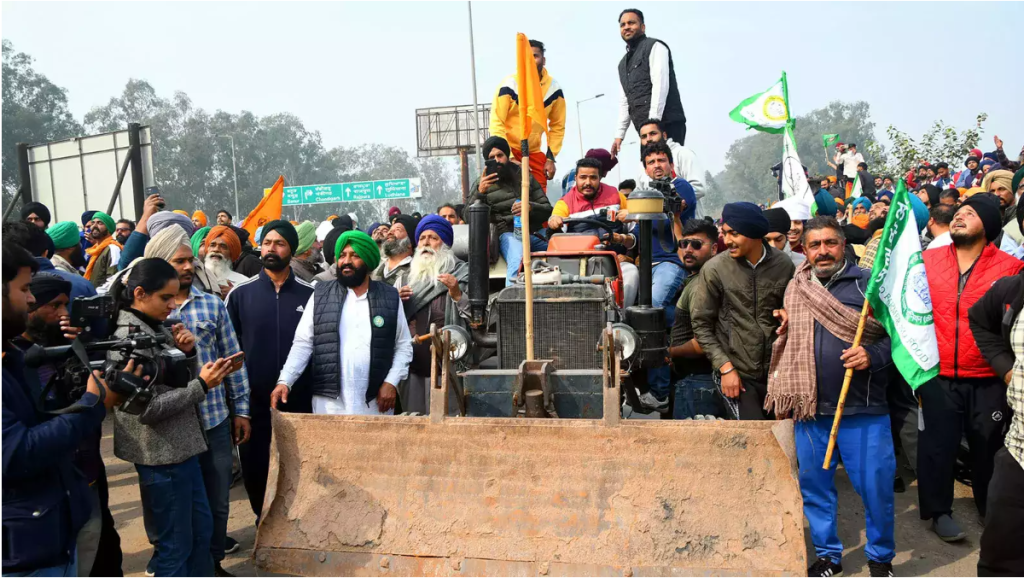With very high debt/GDP ratio and land prices, it is losing out to states like Gujarat
Readers, do not sympathise with powerful farmer unions of Punjab who are on the warpath again. Politicians, beware of the temptation of buying farm votes through surrender just before the general election.
Ever-rising subsidies and props demanded by farmers have bankrupted Punjab. Giving in to farmer demands can ruin other states too. Punjab once had the highest per capita income in India, but pampering farmers has propelled a steady decline over three decades to barely the all-India average. Do not let farmer unions lead the rest of the country down this woeful path.
Readers may be confused. They will ask, did not government props help launch the Green Revolution and make Punjab prosperous? How can the same strategy now be causing its ruin? Answer: subsidies are like drugs. In small doses, they can be stimulants that improve performance. In larger doses, they lead to addiction, falling productivity and financial distress. SS Johl, Punjab’s most eminent farm expert, estimated that four-fifths of the state’s debt was due to free farm electricity. Free electricity encourages water-intensive crops and over-pumping of groundwater, destroying aquifers. But no government dares tell farmers that what boosts profits in the short run is suicidal in the long run.
Punjab is now India’s most indebted state, with a debt/GDP ratio of 48%. Economists Barry Eichengreen and Poonam Gupta estimate this will rise to 55% by 2027-28. The revised Financial Responsibility and Debt Management policy aims to reduce state debt to 20% of GDP. Covid worsened the ratios of all states, but afterwards sensible management has reduced the ratios for almost all. Punjab is going the opposite way.
By contrast, Gujarat’s ratio is down to 20% and projected to fall to 18% in 2027-28. This leaves the state with plenty of spare revenues to invest in infrastructure and productive investment. It has the least farm props among states.
Economics tells us that high farm incomes translate into high land prices. For all their complaints, high farm incomes in Punjab have helped make farmland the most expensive in India, close to one crore per acre in its remotest regions and Rs 5 crore per acre near Mohali. A major reason why industries do not enter Punjab is high land cost.
Tata considered Punjab very seriously for its Nano plant in 2008, but the indebted state could not afford to subsidise industrial land. Gujarat offered cheap, subsidised land. So Tata went there, helping kick-start an auto hub that has attracted several other auto majors. Punjab’s chief secretary complained bitterly to me that Gujarat’s land subsidy was unfair competition. But he could not deny that freebies for farmers had deprived the state of funds for competing.
Farmers do not see the connection between high farm incomes and the lack of industrialisation. They point to industrial subsidies and ask why farmers should not get more. The answer is that industrial subsidies are a small, affordable percentage of GDP, but farm subsidies are too big.
Farmers seek implementation of a price formula suggested by the Swaminathan Commission: Minimum Support Price for crops should be 50% higher than the cost of production. This implies a net profit of 33.33% of sales. Is this reasonable? No, it is outrageous. Ambani and Adani have been accused of crony capitalism. But Reliance Industries’ net profit is 9.4% of sales. It is 1.6% for Adani Enterprises, and 3.3% for Tata Steel. SS Johl remarked acidly, “If the Swaminathan Commission had an economist on it he or she must not have been a very good one.”
The Committee on Agricultural Costs and Prices already considers, among other measures, a 50% profit on operational costs, but excludes the imputed value of assets like land and machinery. Farm unions want a fair return on these assets. But is a 50% return fair? Reliance’s return on assets is 4.78%, while Adani Enterprises is 4.4%. What both have — and farmers don’t — is scale economies. Businessmen can create unlimited new factories and offices, but nobody can create new land. The average farm size is 178 acres in the USA but just 2.6 acres in India. Our land ceiling on irrigated farms is just 15 acres.
Ironically, farm union demands include stricter enforcement of land ceilings, making a virtue of uneconomic holdings. In US, barely 1.2% of the population is in farming, yet feeds US and exports massively too. In India half the population is in farming but produces just 14% of GDP.
Most farmers want to quit farming because land cannot provide a decent living to so many. The focus must be on getting farmers out of agriculture. That means creating more jobs in industry and services through productive investment in higher education and infrastructure. Limited resources should not be diverted to farm freebies that can bankrupt states.
This article was originally published by The Times of India on February 17, 2024.


